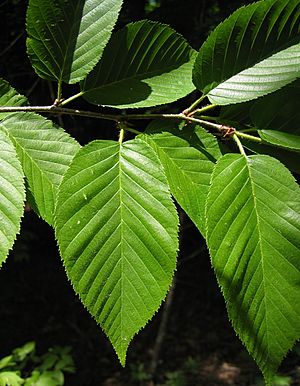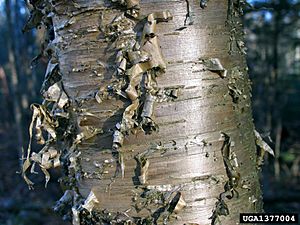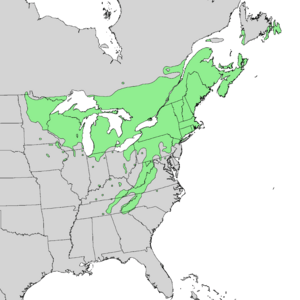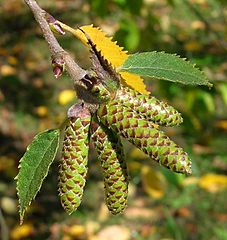Yellow birch facts for kids
Quick facts for kids Yellow birch |
|
|---|---|
 |
|
| Yellow birch foliage | |
 |
|
| Bark | |
| Conservation status | |
| Scientific classification | |
| Genus: |
Betula
|
| Species: |
alleghaniensis
|
 |
|
| Natural range of Betula alleghaniensis | |
| Synonyms | |
|
|
The yellow birch (Betula alleghaniensis) is a large and important tree found in northeastern North America. People also call it the golden birch or swamp birch. Its common names come from the shiny, golden color of its bark. This tree is the official provincial tree of Quebec, Canada. There, it's often called merisier.
Contents
Description
The yellow birch is a medium-sized deciduous tree, meaning it loses its leaves in the fall. It usually grows as a single tree trunk and can reach 60–80 feet (18–24 m) tall. Some can even grow up to 100 ft (30 m)! Its trunk can be 2–3 ft (0.61–0.91 m) wide, making it the biggest birch tree in North America. Yellow birches can live a long time, often 150 years, and some old trees in forests can live for 300 years.
- The bark on older trees is a shiny yellow-bronze color. It peels off in thin, horizontal strips, like paper. The bark often has small black marks and dark horizontal lines called lenticels. Once the tree trunk gets wider than 1 foot, the bark usually stops shredding and becomes more flat.
- The twigs have a slight smell of wintergreen oil if you scratch them. This smell is not as strong as the sweet birch, which is another type of birch tree.
- The leaves grow one after another along the stem. They are oval-shaped with a pointed tip and sometimes a slightly heart-shaped base. They are 2–5 in (5.1–12.7 cm) long and about half as wide. The edges of the leaves are finely serrated, meaning they have small, sharp teeth. The top of the leaf is dark green, and the bottom is lighter with fuzzy veins. In the fall, the leaves turn a bright yellow.
- The petiole (the small stem that connects the leaf to the branch) is very short, about 1⁄4–1⁄2 in (1–1 cm) long.
- The flowers are called catkins. They are pollinated by the wind and open in late spring. Both male and female flowers grow on the same tree, which means the plant is monoecious. The male catkins hang down and are 2–4 in (5–10 cm) long. The female catkins stand upright and are 1.5–3 cm (0.59–1.18 in) long.
- The seed is a tiny, winged samara. It has two wings that are shorter than the seed's width. The seeds ripen and are released in the autumn.
Reproduction and Life Cycle
Yellow birch trees mostly reproduce from seeds. Mature trees usually start making seeds when they are about 40 years old, but some can start as early as 20. The best age for making seeds is around 70 years. Good seed crops don't happen every year; they usually occur every 1 to 4 years.
The seeds grow best on mossy logs, rotting wood, or in cracks in rocks. This is because they can't grow through thick layers of fallen leaves. Sometimes, you might see yellow birches with their roots growing around an old tree stump. When the stump eventually rots away, the birch tree looks like it's standing on stilt-like roots! Young yellow birch trees need some open space and sunlight to grow. They can't grow well in full shade under a thick forest canopy. The tree has deep roots that spread out wide.
How it's like Sweet Birch
Both yellow birch and sweet birch have very similar leaf shapes. Also, if you crush their leaves, both smell like wintergreen. Young trees of these two species can be hard to tell apart. To tell them apart, you need to look at where they grow, their buds, or their bark.
Their growing areas overlap in the Appalachian Mountains. However, sweet birch does not grow west of Ohio or north into Canada, while yellow birch does. Sweet birch also has black bark that doesn't peel, unlike the lighter, bronze-colored, peeling bark of the yellow birch. For young trees, yellow birch can be identified by its fuzzy buds and stems, while sweet birch has smooth buds.
Taxonomy
The scientific name Betula alleghaniensis means "from the Allegheny Mountains". Besides "yellow" or "golden" birch, this tree is also sometimes called gray birch, silver birch, tall birch, and swamp birch. However, some of these names are also used for other types of birch trees.
Range and Climate
The yellow birch grows naturally from Newfoundland in Canada, west to Minnesota, and south along the Appalachian Mountains to northern Georgia. Even though it grows as far south as Georgia, it is most common in the northern parts of its range. In warmer areas, like southern Pennsylvania, it's rare and usually found near water in cool, old forests. It grows best in USDA zones 3-7.
This tree likes cooler weather. You often find it on north-facing slopes, in swamps, along stream banks, and in rich woods. It doesn't grow well in dry places or areas with very hot summers. In such conditions, it might only live for 30–50 years. It can grow in soils with a pH from 4 to 8.
Ecology
Many animals eat parts of the yellow birch. White-tailed deer, moose, and cottontails eat its twigs. If there are too many deer, they can eat too many young trees and stop new birches from growing. Ruffed grouse and various songbirds eat the seeds and buds.
Yellow-bellied sapsuckers, which are birds, drill holes in the thin bark of this tree to drink its sap. Broad-winged hawks in New York often choose yellow birch trees for their nests.
Several types of Lepidoptera (butterflies and moths), like the mourning cloak (Nymphalis antiopa) and dreamy duskywing (Erynnis icelus), eat B. alleghaniensis leaves when they are caterpillars.
Yellow birch often grows with Eastern hemlock trees because they like similar habitats. It usually grows at elevations from 0 to 500 meters, but can be found up to 1000 meters high. It is very important in the areas where low-elevation forests meet high-elevation spruce and fir forests. Because its bark is thin and it can't regrow easily, wildfires can easily kill it.
Sugar maple trees can affect young yellow birch trees. They release chemicals from their roots that slow down the growth of young birches. However, these chemicals don't last long in the soil.
Conservation status in the United States
The yellow birch is listed as endangered in Illinois.
Uses
Yellow birch is very important for lumber. It is the most important hardwood tree used for wood in eastern Canada. Its wood is used for many things, like flooring, furniture, doors, cabinets, and even toothpicks. Most wood sold as "birch" in North America comes from this tree. The wood is strong, has a fine grain, and is heavy. Its color can range from reddish-brown to creamy white. It takes stain well and can be polished to a high shine. Like most birch trees, yellow birch wood can rot quickly if it stays wet. Native Americans used the cellulose from rotting birch logs as a quick way to start fires.
In the past, yellow birch was used to make wood alcohol, acetate of lime, and tar and oils. You can also get oil of wintergreen from its bark.
The papery, shredded bark is very easy to burn because it contains oils. You can peel it off and use it as a fire starter, even when it's wet.
You can tap yellow birch trees for sap, just like sugar maples. The sap has less sugar than maple sap, but it flows in larger amounts. When the sap is boiled down, the wintergreen smell goes away, and you get a syrup similar to maple syrup. The sap can also be used as is, or flavored. You can also make tea from the twigs and the inner bark.
Native American uses
Native Americans used yellow birch for medicine, like a blood purifier. The Ojibwe people made a special drink from the inner bark to help with urination. They also mixed its sap with maple sap to make a pleasant drink. The Ojibwe used the bark of the yellow birch to build homes, canoes, storage containers, and dishes. They also placed it on coffins when burying the dead.







